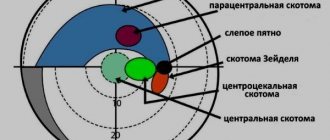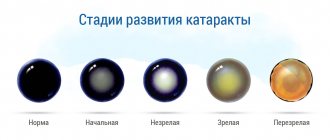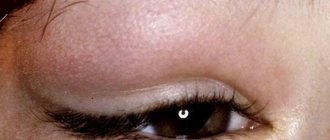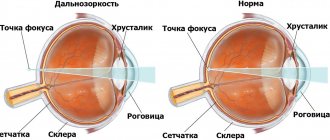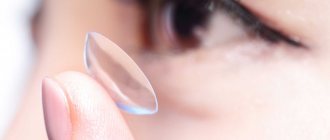Decreased vision in old age can be caused by a change in the transparency of the lens - its gradual clouding. This leads to cataracts. Age-related cataracts are a common disease after sixty years of age, as they are a consequence of general aging and wear and tear of the body. However, with mild clouding of the lens, special glasses can help, and blindness can be treated surgically. Let's consider the issues of cataract prevention, nutrition and treatment of lens pathology.
Types of cataracts in older people
forms of the disease are observed in an elderly person:
:
- Unilateral
type - disease of one pupil; - Bilateral
type - both eyes are affected at once.
The condition is also classified depending on its genesis as congenital or acquired. The congenital variant does not develop over time; Acquired disease is characterized by gradual progression. The acquired variety, in turn, can be traumatic, toxic, or radiation.
By place of origin
opacities cataracts are characterized as
- Nuclear
: pathology formed in the nucleus; - Cortical genesis
: the disease formed in the cortex of the transparent body; - Subcapsular
: the subcortical layers of the eye lens are affected.
More about cataracts
Cataracts in older people are one of the most common eye pathologies. The eye lens is a natural lens that refracts and transmits light rays through it. The lens is located in the eyeball (in the space between the iris and the vitreous body).
Naturally, in youth, most people have an elastic and transparent lens, which allows it to constantly change its shape and be aimed at any object or object. This helps a person to clearly see all objects that are located close or far away from him.
With age, the elasticity of the lens decreases, it begins to thicken, and then loses transparency. All this leads to the fact that the eye loses the ability to transmit light. Against the background of this process, vision decreases, the world around a person becomes fuzzy and blurry. The longer this pathology progresses, the wider the area of turbidity will become. Lack of timely treatment leads to complete loss of vision.
Stages of the disease
- Initial
. Gaps are formed between the fibers of the transparent body due to the accumulation of liquid. Pathology affects peripheral areas; Overall vision is normal. - Immature
. Gradual damage to the central optical areas: the surface of the lens is still quite transparent, but the clouding becomes noticeable. - Mature
. The biological lens is clouded; seals appear; the color of the pupil changes, becoming gray; vision and color perception are impaired. - Overripe
. The tissues of the lens disintegrate, the organ itself loses its properties; blindness occurs. The patient may develop glaucoma.
Phacoemulsification of cataracts with IOL implantation
The patented technology for treating age-related cataracts using phacoemulsification ensures safe, rapid removal of the lens of any degree of density. This is an achievement of modern ophthalmic surgery, characterized by minimal impact on eye tissue. The essence of the operation is to soften the clouded lens, which turns into a liquid emulsion without affecting the rest of the eye structures. In place of the removed lens, an artificial lens is implanted, which takes on the functions of the biological lens of the eye. The procedure takes 15-20 minutes, is performed under local anesthesia, and you can return home the same day.
We offer our patients the latest models of intraocular lenses from leading manufacturers in the USA, Germany, Israel, and Japan. Combined treatment of cataracts with glaucoma and other eye pathologies is also carried out. The price for treatment of age-related cataracts includes a diagnostic examination, consultation with a surgeon, surgery to remove the lens, installation of an IOL, and postoperative observation. Make an appointment to get advice on your case and choose the most optimal way to get rid of cataracts at a favorable price!
Causes of the disease
The disease is based on disorders of interstitial processes in the eye lens, such as:
- disturbances in the arrangement of membranes and biological lens fibers caused by protein polymerization;
- decreased ability to adapt in the transparent body;
- destruction of proteins and the resulting recoloring and clouding of the lens.
Other eye diseases, endocrine diseases of the body, bronchial asthma, diabetes mellitus and rheumatoid disorders can aggravate the situation with cataracts. Negative factors also include negative addictions, lack of vitamins, poor environmental conditions, hard work associated with severe eye strain, and poor nutrition.
Features of age-related vision
A decrease in the elasticity and transparency of the lens occurs naturally. In the initial form of lens pathology, the quality of vision decreases, but few people worry about this. However, this is precisely the reason for a visit to an ophthalmologist, because timely detection of pathology can help preserve vision. The peculiarity of age-related cataracts is that the disease can develop over years.
When the pathology intensifies, a person can only distinguish the outlines of large objects; in a severe stage, the patient distinguishes only the presence or absence of a light source. The patient can accurately point to the light source (lamp, window), but sees nothing else.
Age-related cataracts affect both eyes at once, but to varying degrees. That is, the patient sees better with one eye than with the other. Doctors believe that changes in the lens are associated with metabolic disorders and a lack of vitamin C. With age, natural changes occur in the functioning of the sex glands and the associated functioning of the thyroid gland, which is responsible for human hormonal levels.
Unfortunately, doctors have not established the exact causes of senile lens pathology. However, some unfavorable factors can provoke or accelerate the development of cataracts. These include:
- smoking and alcohol;
- diabetes;
- excessive consumption of heavy foods;
- negative effects of ultraviolet radiation;
- various types of head or eye injuries;
- previous surgery;
- hormonal disorders.
Sometimes cataracts are inherited. That is, if someone in the family had this disease, it may also appear in relatives. Some doctors believe that the provoking factor is poor nutrition and a lack of important microelements in the body.
Symptoms
At first, the disease progresses slowly, without complications. To recognize the disease in time, pay attention to the following symptoms:
- Deterioration of daytime vision and worsening of night vision.
- A person with cataracts begins to see halos around brightly lit objects.
- The lens thickens; this leads to myopia in those who previously suffered from farsightedness;
- The outlines of objects double, blur, fade; discomfort appears, a “film” appears on the pupils.
The manifestation of signs of the disease is associated with the stage of the process:
- Early.
It is characterized by the appearance of “fly spots”, decreased vision over long distances; - Average
, or immature. Glasses no longer help correct vision: perception is as if through a clouded window; - Late
– mature stage. Complete loss of vision up to failure to recognize the light source.
It is most likely to suspect the onset of the disease if the reasons for the deterioration of vision are unclear: the eyes do not hurt, glasses are ineffective, viewing objects is difficult. In such situations, it is necessary to see an ophthalmologist without delay.
Cataract. Mature cataract
Eye cataracts are one of the most common diseases encountered by ophthalmologists,
and is a clouding of the natural lens of the human eye - the crystalline lens. The etiology of this disease can be different: for example, congenital cataract , and professional cataract occurs in representatives of certain professions with corresponding risk factors. There are also post-traumatic cataracts and cataracts that arise as a result of exposure to radiation. However, it is a well-known fact that the “lion’s” share (up to 90%) of cases of this disease is age-related cataract, the causes of which are associated with the aging processes occurring in the body and, accordingly, in the eye. In youth, the substance of the lens is transparent, it itself is elastic, easily changes its curvature and correctly focuses light rays on the retina. Over time, changes in metabolic processes occur in the body, the activity of protective factors decreases, as a result of which the lens of the eye loses its transparency, and its substance gradually hardens and ceases to transmit light. And although, according to statistics, cataracts are most often detected in 60-70-year-old people, in some cases the process of its development occurs earlier, for example, at 40-50 years. That is why, starting at this age, it is imperative to undergo preventive examinations with an ophthalmologist - the earlier the disease is detected, the easier and more effective its treatment will be.
Symptoms characteristic of cataracts are:
- vision that cannot be corrected with glasses and its deterioration towards myopia;
- doubling of objects and their blurriness;
- the appearance of “haze” before the eyes and “halos” around light sources;
- increased photosensitivity;
- deterioration of vision at night, weakening of color perception;
- difficulties when performing small tasks (sewing, reading, knitting).
With cataracts , the above symptoms may occur all at once or only some of them. In any case, if you notice the above symptoms, immediately go to the doctor. At this time, it is best not to wait until the cataract becomes mature.
Cataracts require treatment, the cost of which is incomparable to the losses that can occur if you do not consult an ophthalmologist in a timely manner. After all, what is “at stake” is your vision and the quality of life associated with it.
Diagnostics
Methods to help make an accurate diagnosis:
- Eye pressure indicators
: they must correspond to the norm (except in cases of glaucoma); - Biomicroscopy
is a study using a special slit lamp that allows you to identify cavities of the transparent body filled with liquid. - Ophthalmoscopy
– analysis of the fundus. If the natural lens becomes cloudy, inspection will be difficult. - Perimetry
– measurement of viewing boundaries; with cataracts, the indicators are unchanged. - Ultrasound biomicroscopy
. Recognizes pathological changes in the lens. - Visometry
- visual acuity is determined using ophthalmological tables. - General ultrasound of the eyes
. Detects concomitant diseases. - Keratorefractometry
. A method that determines the elasticity of the cornea and determines visual acuity.
Additional tests are possible if there are concomitant diseases that can provoke the development of cataracts:
- Blood - general examination
: to identify the severity of the inflammatory process; - Rheumatological examination
: the disease may be aggravated by the presence of joint problems; - Blood sugar level
: diabetes mellitus is a catalyst for cataracts.
A patient with suspected disease can be referred to a phthisiatrician, endocrinologist, etc. according to individual characteristics.
The danger of the disease or what will happen if you do not have surgery
If cataracts are left untreated, about half of patients lose vision or develop irreversible diseases such as glaucoma, retinal detachment, and strabismus.
Possible complications of the disease
The development of the disease can lead to the development of such complications:
Phacogenic glaucoma
Left untreated, cataracts can provoke a sharp increase in intraocular pressure as a result of obstructed outflow of intraocular fluid, which causes an enlarged lens.
Phacolytic iridocyclitis
The pathology is accompanied by inflammation of the ciliary body and iris, in which the patient experiences severe headaches. The vascular network of the organ of vision acquires a reddish or bluish tint. Pupil mobility decreases sharply.
Obscurational amblyopia
The disease is characterized by a decrease in visual acuity as a result of impaired visual function; atrophy of the retina and lack of reaction to light are also observed, while structural changes in the organs of vision do not occur. Usually the disease appears due to congenital cataracts. Treatment is carried out only by surgery.
Treatment and prevention
The disease must be dealt with to avoid irreversible complications and vision loss. Only a doctor can prescribe treatment: methods are selected depending on the stage and the personal characteristics of the body. At the initial stage, eye drops, vitamin B2, and ascorbic acid can help. If the cataract has reached a mature stage, surgical intervention and replacement of the eye lens with an artificial analogue is necessary. Alternative treatment for cataracts is also often used. Let's take a closer look at the various methods.
Eye drops
Effective at an early stage, as well as for prevention. Types of means used:
- Taufon:
improves tissue nutrition, reduces pressure inside the eyes, activates restoration processes; - Vicein:
responsible for supplying eye tissue with healing substances; - Quinax:
prevents protein oxidation through the production of necessary enzymes; - Vitafacol:
accelerates the metabolic processes of the biological lens; - Oftan Katahrom:
restores tissue and prevents inflammation.
Surgical intervention
It is carried out at a more serious stage of the disease: the procedure method depends on the general condition of the elderly patient and the presence of certain contraindications and circumstances.
- Laser intervention.
Laser beam surgery is the most gentle treatment option. The method destroys the damaged eye lens and replaces it with an artificial one. - The phacoemulsification method
is a microsurgical operation, which is essentially fragmentation of the transparent body using ultrasound. The removed body is replaced by an analogue. - Extracapsular extraction (ECE)
– removal of destroyed substances of a biological lens through dissection of the cornea with further installation of an intraocular analogue. A distinctive feature is the preservation of the lens capsule itself; - Intracapsular exposure (IEC)
- through a surgical incision, the ocular body is removed along with the capsule in which it is enclosed; To achieve this, the shell is initially frozen to the lens using a cryoextractor.
The technique used and the individual characteristics of the course of the disease can vary the cost of the operation from thirty to more than one hundred thousand rubles. Disabled people, retired people and other beneficiaries are entitled to certain discounts.
Traditional treatment of cataracts
Contrary to popular belief, the unauthorized use of traditional treatment is unacceptable: its use is permitted by the attending physician, and only at a mild stage of the disease. The following traditional means of combating pathology are recognized as effective:
- Various products based on mumiyo, calendula - taken orally;
- Drops obtained from honey water, aloe juice, mumiyo, calendula;
- Increasing the content of certain products in the diet, such as: parsley, buckwheat, sea buckthorn, blueberries, black currants;
- Eye gymnastics that accelerates blood flow in the muscles responsible for the normal position of the lens.
As for the prevention of the disease, it is not so difficult, given the seriousness of the devastating consequences of cataracts. To prevent illness it is recommended:
- Attentive attitude to emerging diseases, especially those that can negatively affect the organs of vision;
- Regular diagnostics;
- A balanced diet, and, if necessary, the use of vitamin complexes and supplements;
- Exercises for the eyes, especially in case of excessive stress;
- Protection of the organs of vision from injury;
- Preventing possible contact with radiation.
As you can see, cataracts are an extremely dangerous disease that can seriously harm the quality of life, especially in older people. The eyes are a fragile but incredibly important organ of our body. That is why you should take the most serious approach to treating the disease, because with timely contact with a competent ophthalmologist, recovery is quite possible. The staff of our boarding house for the elderly is always ready to preserve the quality of life and help in the prevention and treatment of age-related problems. We will take care of the care and maintenance, and you and your loved ones will only have to enjoy communication and the invaluable time spent together.
How to treat age-related cataracts?
A clouded lens cannot be restored to its previous transparency due to irreversible destructive changes. It loses its value as an optical lens. Moreover, a swollen, dense lens negatively affects the condition of other structures of the eye and disrupts the normal circulation of intraocular fluid. The only treatment option for age-related cataracts is to remove the affected lens, but to restore vision it is not enough to remove the blockage to light flow. It is necessary that the light is refracted correctly - this problem is solved by the implantation of an artificial lens, which is installed in place of the removed lens. It is important to understand that such an operation is a matter of time, because no therapeutic treatment can return the lens to its previous refractometric parameters.
Phacoemulsification of cataracts with IOL implantation is the most physiological and reliable way to restore vision in senile cataracts. The technique shows excellent results even in patients over 90 years of age. The operation has no age restrictions, does not require anesthesia, and is carried out according to a strictly verified protocol using high-precision equipment. Elderly people tolerate the intervention well thanks to the gentle effects and honed skills of the clinic’s doctors, whose qualifications are confirmed internationally by relevant documentation. An integrated approach makes treatment as comfortable and effective as possible and ensures a high level of medical and social rehabilitation for the patient.
